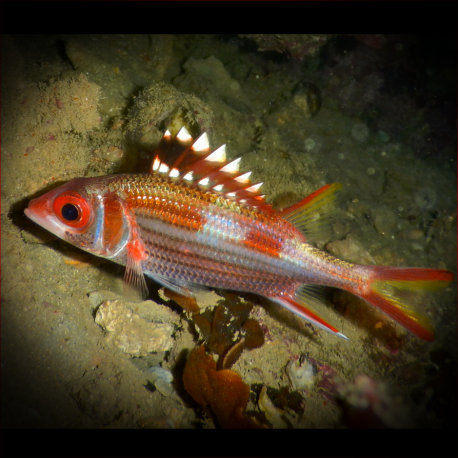More info
Datasheet
| Minimum Tank Size | 800 litres / 211.34 US gallons |
| Maximum Size | 32.0cm / 12.60inches |
| Reef Compatible | Reef safe with caution |
| Temperament | Might be aggressive |
| Temperature | 22.2°C / 71.96°F - 25.6°C / 78.08°F |
| Specific Gravity | 1.020-1.025 |
| Carbonate Hardness | 8-12 |
| pH | 8.1-8.4 |
General Description: The Sammara squirrelfish, also known as Slender squirrelfish, Spotfin squirrelfish, or Bloodspot squirrelfish, belongs to the Holocentridae family. These fish are typically red/grey in color and exhibit secretive behavior, being more active during darkness. They are native to the waters of the Indo-Pacific region, ranging from the Red Sea to Australia and the Hawaiian islands.
Aquarium Suitability: Considered suitable for aquariums, Sammara squirrelfish can coexist with their own species if introduced simultaneously. They might exhibit aggression if not provided with sufficient space. These fish are known to hide amongst stony corals and other structures and can be initially shy when introduced to a tank, becoming more comfortable over time.
Demands: Sammara squirrelfish are hardy and can adapt to varying tank conditions. They prefer dimly lit environments initially and are nocturnal, being most active when the lights are dimmed or turned off. They also require a tank size of at least 800 liters to thrive.
Care and Hardiness: This species is generally not aggressive towards other aquarium inhabitants but may prey on very small fish and invertebrates. Squirrelfish have spikes on their head and gills, making them susceptible to injuries if caught in fishnets. Proper care is essential to avoid potential wounds and damage to their eyes during handling.
Reef Suitability: Considered reef safe with caution, Sammara squirrelfish can coexist with corals but may pose a threat to small crustaceans such as shrimp. It is advisable to monitor their behavior closely in a reef tank setting.
Aquarium Setup: Setting up the aquarium for Sammara squirrelfish involves providing hiding spots within rockwork or corals, mimicking their natural habitat. Dim lighting initially can help acclimate them to the tank, with gradual increases to normal lighting levels. Monitoring tank mates for compatibility is crucial due to their potential aggression.
Behaviour: These fish tend to be more active during nighttime and may require live food initially to encourage feeding. They are known to exhibit aggressiveness if space is limited, and multiple specimens can be kept together with proper tank size and structure to reduce potential conflicts.
Feeding and Diet: Sammara squirrelfish have a varied diet, including fish, larger crustaceans, other invertebrates, and small crustaceans like krill and artemia. Ensuring a balanced diet is important for their overall health and well-being in captivity.
Dimorphism and Captive Reproduction: n/a
Habitat and Distribution: In the wild, Sammara squirrelfish can be found in the East Indian Ocean, West Indian Ocean, Australia, the Red Sea, Indonesia, and the Central/West Pacific region. They typically inhabit coral reefs and rocky crevices, preferring areas with low light where they can hide and forage for food.

